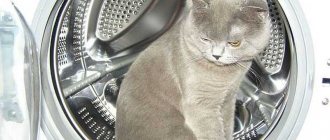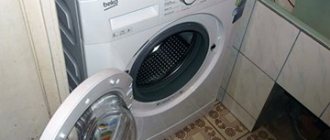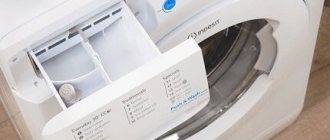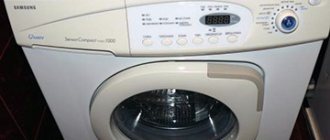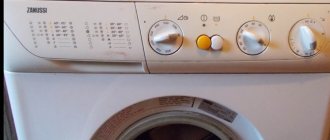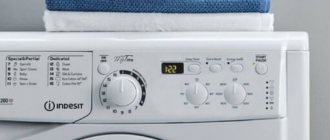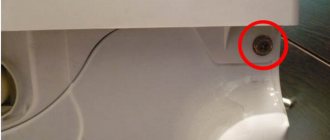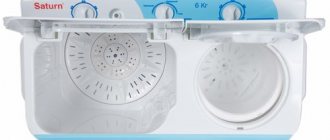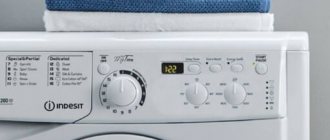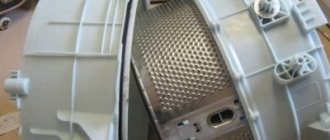Any household appliance does not last forever, and a washing machine is no exception. As a result of prolonged use or careless use, the elements of the device wear out and collapse, and the equipment becomes unusable. In some cases, it is possible to repair washing machines yourself. But if major problems occur, it is better to contact a service center.
The device of washing machines
Few owners of a washing machine think about its design and operating principles. However, in order to independently repair a faulty automatic washing machine at home, you need to know its internal structure and the purpose of the main components and parts.
Control
The main part in a modern washing machine is the control module. It is with the help of the control board, which is a metal substrate with many resistors, diodes and other elements, that all washing processes take place: starting and stopping the machine, heating and draining water, spinning and drying clothes.
The module receives information from special sensors about how to act at a given time. The machine uses three sensors:
- pressure switch - shows the water level in the tank;
- thermostat - determines the water temperature;
- tachometer - controls the number of engine revolutions.
The control module is not only the most important, but also the most expensive part of the washing device. If it fails, the machine begins to act strange or completely refuse to do its job. Without special skills in repairing electronic equipment, you should not repair the board yourself. Most often, this part is completely changed or sent to professionals for repair.
Execution devices
Having received the appropriate washing instructions from the owner of the machine (mode, water temperature, the need for additional rinsing, etc.), and having checked the condition of the sensors, the control module gives the necessary orders to the executing mechanisms.
- Using a special UBL device, the loading hatch door is blocked. The machine will remain in this state until the end of the wash, and only 2-3 minutes after draining the water, the control module will signal to unlock the hatch.
- Water is supplied through the valve into the tank of the device. As soon as the pressure switch shows that the tank is full, the water supply will automatically stop.
- A tubular electric heater (TEH) is responsible for heating the water. From the module it receives a signal about the turn-on time and the temperature to which it is necessary to heat the water in the tank.
- The machine’s engine, which is connected through a belt or directly to the drum pulley, is responsible for rotating the drum. The moment of starting and stopping, as well as the rotation speed, is controlled by the control module.
- Waste water is drained using a pump. The drain pump pumps water out of the drum and sends it into the sewer pipe.
Such seemingly simple mechanisms, controlled by an electronic module, perform all the work of the washing unit.
Washing machine tank
The tank is a sealed plastic container that occupies most of the body of the washing machine. Inside the tank there is a drum for loading laundry and a heating element.
The washing machine tub consists of two parts connected by metal brackets or bolts. Water is taken in and drained through special pipes connected to the walls of the tank. To reduce the vibration that occurs when the drum rotates, the upper part of the tank is attached to the machine body with springs, and the lower part with shock absorbers.
The drum is made of high quality stainless metal. By rotating in it, the laundry is washed and wrung out, completely free of dirt. A rubber cuff located between the tank and the drum ensures the tightness of the structure.
Common faults and how to detect them
Not every person can immediately figure out how to repair a particular component of a washing machine. Nowadays, the World Wide Web comes to the aid of people. It’s as easy as shelling pears to open any video on this topic, and it will immediately become clearer how to restore the functionality of a device or a separate node. All washing machine malfunctions can be classified into several groups:
- No washing mode connection;
- No water is taken;
- Water cannot be heated;
- The drum does not rotate;
- Difficulty draining water;
- Increased vibration of the device.
Any malfunction of the home assistant leads to a rapid accumulation of unclean laundry. The popular model of the Indesit corporation has long captivated consumers with its ease of maintenance and high reliability of performance. You should always remember: when repairing an Indesit washing machine with your own hands, you must always observe the basic safety provisions and strictly adhere to them. The machine has broken down, but it is still under warranty. In such cases, it will be better and cheaper to call a service center specialist to your home.
Problems and their solutions
Every housewife is familiar with the unpleasant situation when the washing machine breaks down and the laundry has to be washed manually. In some cases, you can fix the problem yourself, without resorting to the help of specialists. Here is a list of problems whose solution does not require special qualifications.
Wash does not turn on
One of the common problems that arise with washing machines is when the wash cycle does not start when you press the power button. If the indicators on the control panel do not light up, then the problem is in the electrical supply of the unit. You need to check the socket, plug and surge protector.
In the case when the machine does not turn on, but all the indicators are blinking, you can suspect a breakdown of the UBL or the control module. Any novice technician can figure out the socket, but replacing the UBL or electronic board should be done by a specialist.
Water does not fill
In the event that water does not fill the tank, first of all you need to check whether there is water in the water supply system. After making sure that everything is fine in this regard, you need to clean the supply hose and inlet filter. If malfunctions in the water supply units are excluded, then the control unit is broken.
Water does not heat up
You can find out that the water is not heating up by touching the glass of the loading hatch. If the set washing mode provides a temperature of more than +30°C, and the glass remains cold, then the problem is obvious.
There are several reasons for the malfunction:
- the heating element has burned out;
- The thermostat has failed;
- program error.
The heating element and thermostat are consumable components that require replacement from time to time. To eliminate the control module error, you need to restart the program. If the problem persists, you will have to change the software device.
The drum does not spin
Another unpleasant situation is that the machine works, but the drum does not spin. In this situation, the following problems are suspected:
- the drive belt breaks or falls off - the drum can be easily turned by hand;
- the engine stopped;
- a foreign object is stuck between the tank and the drum;
- program error.
The owner of the machine can remove the stuck object himself, but to repair the engine and replace the belt, it is better to contact a workshop.
Water does not drain
The drain pump (pump) is responsible for draining waste water. To prevent small items left in the pockets of clothes due to the housewife's absent-mindedness from clogging the sewer pipe, the pump is equipped with a filter that should be cleaned occasionally. If the filter is clogged or the pump is broken, the machine will not discharge dirty water. The way out of this situation is very simple - clean the filter or change the drain pump. Only an experienced technician can repair the pump.
Water is leaking from the washing machine
It happens that during washing, water leaks from the machine onto the floor. It's important to keep track of how often this happens. If such a problem happens once (for example, when washing tulle), you need to use less powder. The fact is that light matter whips up a lot of foam, which seeps into the smallest technological holes and spreads across the floor in the form of puddles.
In the case when water leaks out every time you wash, the causes of the malfunction are as follows:
- the gasket on the water supply hose is cracked;
- the rubber cuff of the hatch was torn;
- The pipe lets water through.
Having discovered exactly where the machine is leaking water, you need to replace the damaged parts. In case of such breakdowns, repairing the washing machine at home with your own hands will not be difficult.
The car vibrates a lot
A serviceable modern machine is quite quiet. If the unit knocks and roars like a rocket during launch, you need to look for a malfunction.
Causes of knocking:
- incorrect installation - during installation, you must ensure that the machine stands firmly on the floor, in the same plane;
- foreign object stuck between the tank and the drum;
- worn bearing;
- imbalance when loading laundry;
- failed shock absorbers.
If the cause of the malfunction lies in worn shock absorbers and bearings, the parts will have to be replaced. In other cases, you need to use the washing machine correctly: when loading laundry, distribute it evenly in the drum, remove foreign objects from clothing pockets, and wash problematic items in bags.
Loading hatch does not open
The wash ended normally, but it is not possible to open the hatch door. There are several reasons for the problem:
- the handle or door lock is broken - replacement of worn-out fittings is required;
- The hatch locking device does not work;
- The control module has failed.
If the door lock is due to a program error, you need to unplug the machine for a few minutes and then try to open the hatch again. If the UBL breaks down, the device will have to be replaced. You can do this yourself.
Doesn't wring out
Usually the washing process ends with spinning the laundry. The machine does not dump water and refuses to spin clothes in the following situations:
- The washing program is set incorrectly - when washing wool, silk and other delicate materials, spinning is not provided by the manufacturer;
- laundry imbalance - the drum cannot rotate at high speeds, since the laundry is unevenly distributed inside the machine;
- the pump is broken, the machine does not discharge water and, as a result, does not proceed to the spin cycle;
- the tachometer may break;
- Problems with the motor, such as brush wear.
In any of these cases, you must first disconnect the device from the network, remove water from the tank through the drain hole in the pump, unlock the door, and only then look for the cause of the failure.
Electric shock
The washing machine is an electrical appliance that requires grounding when installed. If the housing is electrocuted, it means the electrical wiring is faulty. The cause of the problem may be a break in the wires inside the machine, a breakdown of the heating element or motor. In any case, it is necessary to urgently find the location of the electrical leak and eliminate the malfunction, otherwise it is unsafe to use the device.
Repair
Repairing washing machine faults requires skills in working with tools and at least minimal knowledge of electronic equipment. The approximate work plan presented below will allow you to avoid annoying mistakes and eliminate problems yourself.
Washing machine pumps
Even professionals rarely attempt to repair a broken drain pump. This device is not too expensive and is easier to replace entirely. The main thing is to find a part of a suitable brand in the store.
The pump is replaced as follows.
- Remove the bottom panel.
- Using a screwdriver, disconnect the pump from the machine body.
- By pressing on the drain valve from the outside, push the pump inside the housing and pull it out.
- Disconnect all wires leading to the pump.
- Remove the drain hose and pipe.
- Installing a new device.
After this, you need to reassemble the washing machine, performing all the steps in reverse order, put it in the working position and check the operation of the new part by turning on the wash without laundry.
Washing machine control module
In many models, the control board is located at the top of the front of the machine; removing it is not difficult. Having freed the substrate with the microcircuit from the fixing strips, you need to carefully examine it. Signs that repairs are needed include:
- the plate has changed color in some places, the tracks have darkened;
- torn capacitor caps;
- The place where the main processor is installed has darkened.
If you discover one of these defects, it is better to immediately contact the workshop. After all, to repair a microcircuit you will need both the appropriate skills and the ability to work with a soldering iron.
Bearing replacement
If the washing machine starts spinning loudly, then one of the reasons may be damage to the bearing. To change bearings in a top-loading machine, you must:
- Disassemble the device body and remove the back wall.
- Remove the belt from the pulley, allowing access to the bearing system.
- Unscrew the central bolt securing the pulley to the drum and remove the pulley.
- Unscrew the three screws securing the structure and remove the coupling with bearings.
- Remove the O-ring and oil seal from the shaft, which will also have to be replaced.
Then all that remains is to install new parts and reassemble the washing machine, doing the work in reverse order.
Replacing the heating element
The heating element often requires replacement. It can burn out from long-term use or unstable voltage in the electrical network. From constant contact with water, the tubes of the heating device become covered with scale.
Changing the heating element is not difficult, you just need to do the following:
- Remove the back panel, since most often the heating element is located in the rear of the case.
- Disconnect the electrical appliance connection terminals.
- To remove a faulty heating element, you need to unscrew the nut using a wrench and press on the stud with a screwdriver. Use a twisting motion to remove the damaged part from the seal.
- Install the new part, trying to place the heating element evenly, without deforming the seal.
- Insert the stud into place, tighten the nut, and connect the wires.
By photographing the position of the parts and wires before disassembling, you can make your work much easier.
How to avoid malfunctions?
We are not insured against the fact that the automatic washing machine does not have defects made at the factory, or its parts are not subject to natural wear and tear. Even the highest quality washing equipment is unable to work for a long time, because it is influenced by numerous factors:
- quality of water,
- electrical network,
- operational features,
- execution of the assembly,
- various accidents.
But if you adhere to the rules for operating devices for washing clothes, and promptly carry out preventive measures to remove scale, etc., the machine will work much longer than the manufacturer guarantees. True, you will have to devote a little more free time to your washing machine, which is completely justified.
Experts assure that the ideal option is to partially disassemble the washing machine and inspect it for damage.
You don’t have to do this yourself - you can hire a technician to check all the main units.
